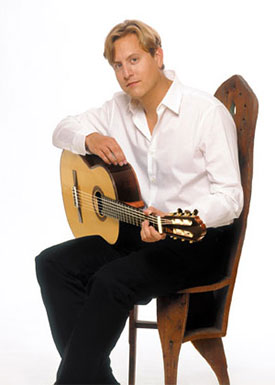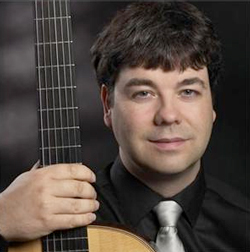by Daniel Hathaway, James Flood & Mike Telin

Jason Vieaux
Representing the host of Classical Guitar Weekend, Cleveland Institute of Music guitar professor Jason Vieaux sometimes caps off the weekend’s activities, but this time was the headliner for Thursday evening’s opening concert. After playing a sweet and beautifully layered performance of Fernando Sor’s Bagatellle, op. 44, no. 3, Vieaux told the audience that he had decided to revisit repertory he had played over the years at Classical Guitar Weekend, after working on some of the pieces on the program with students and recalling how much he liked them.
Manuel Ponce’s sunny Sonatina Meridional followed. Campo featured rhythmic flair, suppleness and clear articulation, while Copla was soulful and Fiesta full of color contrasts.
Vieaux continued his program with Sor’s Fantaisie élégiaque, op. 59, a memorial to the composer’s student, Charlotte Beslay. The introduction, an ornate and expressive recitative and aria with operatic roots, led to a reverent, sad Marche Funèbre which Vieaux played at an exquisitely measured pace. His concentration and intensity obviously inspired the audience, who hung on every expressive note.
After intermission, Vieaux was joined by violinist Jinjoo Cho and cellist Melissa Kraut for Piazzolla’s Oblivion. An elaborate guitar cadenza set up a fine performance of this well-known nuevo tango work which needed just a bit more sultry, mercurial passion to sound truly Argentine. Niccolò Paganini’s delightful Terzetto Concertante brought Kraut back to the stage along with violist Jeffrey Irvine. Though marred by intonation problems in the strings and a few unlucky page turns, the Paganini and the Piazzolla revealed Jason Vieaux to be a first-class chamber musician — a role more guitarists should explore. His big moment in the Trio of the Menuetto was delicious. —D.H.
Jiyeon Kim

Lennox Berkeley’s Sonatina, op. 52 began with a pleasant ramble in the country that morphed into a more dissonant, contemplative mood before returning to its original musical inspirations.
A new work, Riho Esko Maimets’s .:i:.:ili:.:i:. (pronounced eye-illy-eye) was described by its composer (who was in the audience) as a) evoking both the physical effort involved in climbing a mountain and the repose one feels on reaching the summit and b) “a percussion piece for the guitar.” The first part was indeed rhythmic and labored, with caesuras (rest stops?) every now and again alternating with slides. The second section was calm and pointillistic.
In other works by Ponce (Theme, variations and finale), Regondi (Introduction et Caprice), Tarrega (Lagrima, Adelita and La Alborada) and Mangoré (Un Sueño en la Floresta), Kim showed herself to be a rising artist with fine technique and an engaging stage presence. As she becomes more experienced, no doubt she’ll learn how to play with more presence in a large room. The audience gave her a warm reception and Kim responded with an assured performance of the first piece she had ever learned, Albeniz’s Asturias. —DH
Colin Davin

Opening the recital with his own transcription of the Violin Sonata no. 3, BWV 1005, Davin journeyed through the meditative opening Adagio with care and sensitivity, assuring that each section was given its own character. He handled the massive, 10-minute-long Fugue with perfection, executing its seemingly endless counterpoint with precision, musical intelligence and passion, and expertly delineating all its sections so that the audience’s mind was never allowed to wander.
Bach’s final movements for solo instrument usually feature a rush of merciless and unremitting sixteenth notes at a lively tempo. Davin met the challenge here with style and ease. Contrasting and deftly alternating between loud and soft dynamics, Davin delivered an exciting performance of the closing movement which almost had a “swing’ to it. He pulled key melodic notes out of the mix of fast sixteenths while skillfully allowing the remaining notes to serve their rhythmic and harmonic functions. At the conclusion of the Bach, and after the generous applause died down, Davin exclaimed “That’s hard!”
Joan Tower’s Clocks is full of colors and moods as it imitates a vast array of devices from the majestic clock tower to the tiny pocket watch. In order to aurally project images, one has to have not only a beautiful tone, but a fine control of tone colorings. Davin does this excellently, enlivening the listener’s imagination. In fact, the imagination is a driving force in Davin’s musical mission. Frequently he looks away from the instrument to seemingly gaze at an abstract scene from his imagination, as if to cajole his fingers into reproducing what he sees in his mind’s eye — and it works for him.
In the second half Davin gave a passionate premiere of Erin Rogers’s Another Sky, which was composed specifically for him. This was followed by another Bach work, the Cello Suite no. 6, BWV 1012. The Allemande was beautifully rendered at a slow tempo and tightly packed with lovely, well-shaped ornaments. The Courante danced and affected some compelling color contrasts. The folk-like Gavotte II was playful. Davin played the opening bars of the Gigue at a low dynamic level, a small example of the originality and boldness that characterized the evening. The remainder of the movement was a frolic as a gigue should be, and played with mastery.
Davin closed with a 20th century classic, Benjamin Britten’s Nocturnal after John Dowland, op. 70, based on John Dowland’s lute-song Come, Heavy Sleep. Davin convincingly captured the various moods of each of the variations, playing pristine single lines, fast scales and cleanly executed repeated notes. The unforgettable eighth variation features a descending, foreboding bass line that is repetitive and unrelenting. Davin gradually built up this lengthy section with increasing intensity, then moved into the peaceful and unapologetically tonal final section (the actual theme) without veering from a soft dynamic level, another bold stroke that was accomplished to a beautiful and mesmerizing effect.
Davin responded to a standing ovation with two encores. With both his parents present, he first tenderly played his mother’s favorite, Augustin Barrios’s Julia Florida, and came out again to play an exciting kicker, his father’s favorite, Misionera (arranged by Jorge Morel). —JF
Raphaëlla Smits

Sor’s Fantaisie élégiaque, op. 59 was still fresh in the ears of many from Jason Vieaux’s performance on Thursday, but Smits put her own distinctive mark on the work. Playing on a mellow Mirecourt instrument made in the 1830s and restored by Bernhard Kresse, she produced a complex sound abounding in color contrasts. Her Marche Funèbre was a relatively lively procession infused with layers of lyricism.
J.S. Bach’s Partita secunda for solo violin gave Smits further opportunities to demonstrate her mastery of color. The dreamy Allemande, rhythmic but supple Sarabande and introverted Sarabanda led to a clear, flowing and dextrous Giga. Then, as one of Bach’s most masterful afterthoughts, came the immense Ciaccona.
If you can forget you ever heard the Chaconne played on the violin, it makes a fine effect on the guitar in the right hands, and Smits’s were the right hands for the task. Beginning dead slow and solemnly, she paced its thirty permutations masterfully, fleetly fingering runs in its more active variations. So intensely did she engage the audience that a small memory slip had the effect of a transient earthquake, but she recovered her composure immediately.
Bach followed intermission as well (after a stage manager had reminded the audience about noise-making devices — possibly a cell phone had distracted Smits earlier). The cello suite BWV 1011 was delightful, its prelude special for Smits’s articulations and dialogues with herself in different voicings, its Gavottes en Rondeaux arresting for their wild middle section.
Smits inadvertently transposed her final pair of selections by Johann Kaspar Mertz, playing Le Romantique, Grand Fantaisie before the Elegy, but the new order of things seemed just right, and ending on an elegiac note was not a problem. She offered Sor’s Variations on a Theme by Mozart, op. 9 in response to applause that was as warm as her sound had been throughout this program. —DH
Jonathan Leathwood

The music of Bach made appearances during three of the five recitals during this year’s Classical Guitar Weekend, and it was interesting to hear how each performer approached the composer’s music. Leathwood gave a musically deliberate performance of the Lute Suite in E minor, BWV 996, playing with clear articulations during the Courante. His performance of the Sarabande was exquisite.
The first composers represented as part of the Spanish Civil War subtext were Manuel de Falla and Roberto Gerhard; the first went into exile in Argentina and the later to Cambridge, England. De Falla’s Homenaje: le Tombeau de Claude Debussy is a lovely tribute to the composer’s mentor, Debussy, and followed directly by Gerhard’s Fantasia, created the illusion of the shared tragedy caused by the war.
The back story of Sonatina after a Concerto by Stephen Goss may be more interesting then the work itself, at least in the composer’s arrangement for solo guitar. After completing the concerto, the composer arranged the middle and first movements for solo guitar and Leathwood asked him the do the same for the third and final movement. The movement titles, Circle Line after the London underground line of the same name, Marylebone Elegy, an homage to a young British guitarist who had recently died of leukemia, and Canary Wharf, an area of London located on the West India docks, all make interesting subjects. However, even in Leathwood’s extremely gifted hands the work feels somewhat incomplete and leaves one wanting to hear it performed as a concerto with orchestra.
Leathwood displayed his technical ability during studies #5, #8, and #10 from Villa-Lobos’s 12 Studies for Guitar, and during Catalonian guitarist, teacher and composer Miguel Llobet’s arrangements of Three Catalonian Folk Songs, Leathwood created sublime musical phrases; each song became a tone poem in miniature.
Shot and killed during the Spanish Civil War, composer Antonio José’s Sonata concluded the program. An episodic composition in four movements, the piece is full of rich harmonies that are, like the de Falla, influenced by the music of France, especially Ravel. Jonathan Leathwood made easy work of the opening Allegro moderato’s complex rhythms. He tossed off the Minueto with panache. The Pavana triste was passionate, and the final ended the sonata with flair.
Leathwood, acknowledging the appreciative ovation from the audience, treated them to a final hearing of the music of Bach. A fitting way to conclude his recital and the 2013 edition of Classical Guitar Weekend. —MT
Published on ClevelandClassical.com May 28, 2013
Click here for a printable version of this article.



